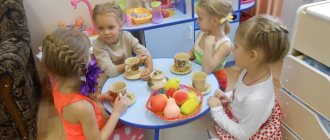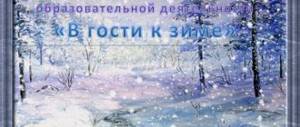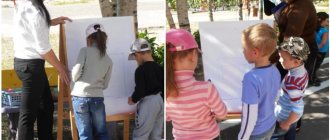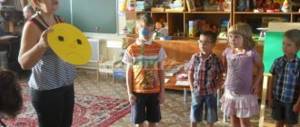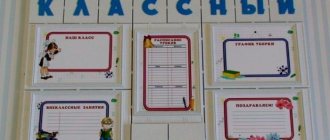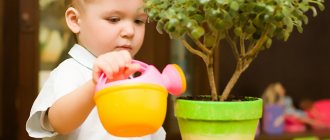Visiting Droplet: direct educational activities in the middle group
Mukhatdinova S.S., Tochilina O.L. Visiting Droplet: direct educational activities in the middle group // Sovushka. 2020. N 4 (18). URL: https://kssovushka.ru/zhurnal/18/ (date of access: 10.10.2020).
Order No. 508362
Integration of educational areas: social and communicative development, cognitive development, speech development, artistic and aesthetic development, physical development.
Tasks:
Educational:
- to strengthen children’s understanding of the sea and its inhabitants, about types of transport, to teach them independently and creatively to use equipment with sand and elements of toys of sea inhabitants, to expand and enrich children’s vocabulary,
- consolidate children's knowledge about the properties of sand through experience,
- learn to solve problem-search problems.
Educational:
- develop cognitive interest in nature, cognitive abilities,
- develop imagination, color perception, sense of composition, creativity,
- develop basic research skills,
- communication skills.
Educational:
- cultivate responsiveness, the ability to show creativity, curiosity, collectivism and interest in natural materials.
Types of activities: cognitive-research, play, productive, problem situation, surprise moment, explanation of the teacher, analysis of the work of children and the teacher.
Methods and techniques
- Game situation, game technique.
- Choral and individual responses.
- Polls.
- Showing methods of action.
- Physical exercise.
Individual work
- Monitor the correct completion of tasks.
- Develop self-control skills in children.
Materials and equipment : pictures depicting transport (motorcycle, train, plane, ship), soft modules for building a ship, a turtle toy, sand molds, kinetic sand, river sand, a sheet of Whatman paper, a gift set “Inhabitants of the Sea.”
Progress of direct educational activities
Educator: Guys! Let's gather in a circle!
Circle of Joy
All the children gathered in a circle
I am your friend and you are my friend
Let's hold hands tightly
And let's smile at each other
Educator: Now listen to what happened to me today. This is some amazing story! I was walking to work today, the snow began to melt, and a bottle with a letter was floating in a small stream. I didn’t have time to read it, so I decided to bring it and read it with you. Does this bottle remind you of anything? (children: yes, sailors and pirates sent letters to these, or people lost at sea.)
Are you wondering what's in this letter? (Yes...) Let's get the message.
Text of the letter
Hello guys! My name is Droplet, I hatched from an egg on a small uninhabited island. I feel very lonely here and I would like to have a lot of friends. To do this, I want to invite you to visit me so that you can help me make new friends.
Educator: Well, guys, do you want to go visit Droplet? (Yes…)
Educator: Guys, can you tell me what an island is? (A piece of land among the water).
Educator: Yes, guys, that’s right, the island is such a small part of the earth that is surrounded on all sides by water, and since our island is in the sea, it means it is surrounded by the sea.
Educator: Children, let’s think about what kind of transport is best for you and me to go on, so that our journey becomes very interesting (children’s answers, choice of transport from the pictures offered on the easel). A motorcycle - can we sail on the sea on it (no, it will drown), a train - we can’t either, it will drown too, an airplane - but we can’t sail on an airplane, but we can fly over, only from above we will see only a small part sushi, so it’s better to go on a sea voyage by ship.
Educator: My friends, this morning you built a wonderful ship. Maybe we can go on it? (Yes...) To do this we need to climb the ladder. But, my dears, let's take sand sets with us, they might come in handy. So, let's all take our seats and look only forward.
This is the sea, this is the shore,
This is my brave boat
It's the wind that's risen
There is a strong blow in the sails.
Rush, little boat, across the waves
To the farthest shores!
The music “Sound of the Sea” plays, children are asked to close their eyes and listen. Then the teacher asks a question what the children heard.
Educator: That's right, guys, this is the sound of a sea wave, which means you and I are on the open sea, look who's ahead.
Slide show:
But they are swimming past us? "Dolphins" (dolphins love to swim next to ships),
And this? “Whale” (you will recognize this whale as the largest sea animal),
“Shark” (and this shark is the most dangerous predator in the sea),
“A school of fish” (here are the fish, what color are they),
“Sea urchins” (these are sea urchins, they have the same spines as forest urchins),
"Octopus" (look it's an octopus),
"Sea Horse"
“Jellyfish” (there are jellyfish among them, and they can sting poisonous ones),
“Starfish” (guys, let’s count how many rays they have),
“Turtles” (or maybe this is our friend, “Droplet” who is waiting for us on the island, look, turtles hatch from eggs like chickens),
“Island” (so we ended up on the island)
Educator: Guys, we have arrived on the island, let's go down the ladder from our ship, and now look around both to the right and to the left (a turtle enters). Children, look who is greeting us. This is our new friend “Droplet” turtle.
Droplet: Hello, friends! I am so glad to see you on this island. Let’s get to know each other quickly, I’m “Droplet”, what’s your name? (children take turns saying their names). Tell me guys what did you see when you sailed to the island (children's answers). My friends, I invited you to my island, because I live here alone and I’m very bored. I would like you to help me and make sea creatures out of sand, then I will have more fun on the island.
Educator: Let's now go to the table. (There is a sheet of whatman paper on the table, and on it is depicted “a part of the sea surface” in the center of an island with sand) Children, let’s examine the sand, tell us what color it is, touch it with your hands and how it feels to the touch (loose, yellow, dry). Do you think it will be possible to make sea inhabitants out of dry sand? (No)
Then the teacher draws the children’s attention to another container with kinetic sand and invites them to touch it.
Educator: these are children, the sand is also kinetic, you can play with it both at home and in the kindergarten, it is plastic and does not crumble, you can make various figures from it. So guys, what kind of sand do you think is best for us to use to create friends for our turtle? (children's answers).
Educator: Of course, you are absolutely right.
The teacher explains to the children that the blue sheet of paper lying on the table is the sea. Also on the table are containers with kinetic sand (colored), molds of sea creatures, plastic toys, and seashells.
Group work of children accompanied by music. During work, the teacher praises the children for the work done. They take a photo for memory.
Physical exercise: musical (“And fish swim in the sea..”)
Surprise moment: a turtle gives shells to children.
Droplet: Goodbye, my friends, now I’m not alone, I have you. Thank you very much.
Educator: Guys, let’s say thank you to the turtle “Droplet”. And it’s time for you and me to return back to our group, let’s wave to “Kapelka” - goodbye! (boarded the ship, sailed into the group, sound of the sea)
Educator: guys, we had an exciting trip, let's remember where we went today (on a tropical island visiting Droplet), and why we went to this island. Let's remember who you and I saw when we were sailing on the sea (jellyfish, sharks, dolphins, etc.), what you liked the most. Look at the photo we took and remember what we made our sea creatures from and which ones. (Reflection: children look at the photo of their collective work, remember where they visited, who they saw there, what the inhabitants of the sea are made of.) Tell me, did you enjoy the sea voyage?
Educator: Guys! And I have another surprise for you!
I prepared coloring books. In your free time or at home, you can remember the sea creatures and color them.
